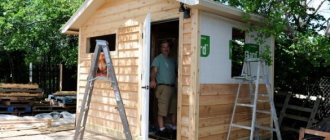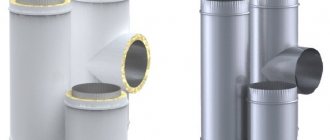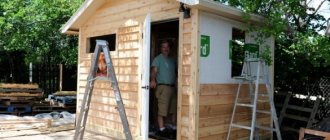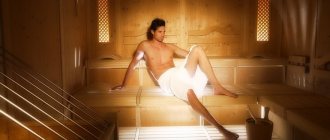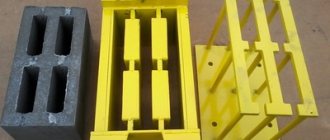In order for a self-built bathhouse to delight you with steam and warmth for decades to come, it is important to carry out all pipe and stove work in it strictly according to the rules. It’s not difficult - their whole point is to properly remove smoke and protect the walls from the heated sauna stove. But ignoring these rules usually leads to dire consequences - from carbon monoxide poisoning to calling the fire department. Therefore, knowing about the main points will be useful even for the owner of a bathhouse who is quite far from construction.
Fire safety standards in bathhouses
Stove heating is considered a fire hazard, and therefore is allowed according to SNiP 41-01-2003 only in one-story bathhouses with no more than 25 seats (people). The stove is dangerous primarily because wood burns in it. If the stove is used carelessly, burning logs may be dumped, sparks and flames may be released from the firebox door, or fire may be released in the event of emergency destruction of the stove walls.
The formation of cracks in brick and metal stoves, although an emergency, seems to be a common occurrence in everyday life. These cracks are especially dangerous in areas that are inaccessible to routine visual inspection, such as areas adjacent to wooden walls and ceilings.
Even small cracks with a thickness of only 2-3 mm can be dangerous, and in brick kilns due to the fact that fluffy soot can accumulate in them: either resinous at the beginning of the fire in the chimneys, or dry in the chimney. Dry soot, but fresh, is more dangerous. A layer of soot more than 2-3 mm thick is already capable of igniting from sparks in flue gases.
A smooth, dull hum suddenly appears in the chimneys, a smooth yellow glow without flashes appears in the cracks of the cleaning holes and valves, and a wide, blurry plume of smoke emerges from the chimney on the roof with the possible appearance of sparks and even flames.
Soot combustion occurs in smoldering mode in much the same way as tissue paper smolderes - with a slow front that easily penetrates into all the nooks and crannies of the smoke system, including emergency cracks, burnouts and technological openings (doors, valves), also usually clogged with soot.
Heated surfaces of ovens can also pose a danger. In accordance with SNiP 41-01-2003, the maximum temperature of the furnace surface “should not exceed 120°C on a furnace area of no more than 5% of the total surface area of the furnace” (and on areas of more than 5% it can exceed 120°C?!).
This inarticulateness has been living in SNiPs since 1975! In rooms with temporary occupancy, when installing protective screens, it is allowed to use ovens with a surface temperature above 120°C.
Such norms are very vague and are perceived by summer residents simply as measures to prevent burns from touching. In particular, it is not explained what a screen is, what screen designs are permissible, and whether stoves with wall temperatures above 120°C are allowed in rooms where there are no people at all.
At the same time, SNiP 41-01-2003 does not limit the temperature of cast iron flooring, doors and other stove appliances.
The state standard GOST 9817-95 is more specific, without any reservations it is established that the temperature of the outer surfaces of the apparatus (domestic, solid fuel-burning) should not exceed 120°C on the front and rear walls and 80°C on the side walls, and the floor temperature is below the device should not be more than 50°C. At the same time, the standard, while providing for the presence of a hob, does not stipulate in any way the temperature requirements for it.
Fire safety standards NPB 252-98, also recognizing a temperature of 120°C as the maximum for the external surfaces of stoves, nevertheless allow in rooms with temporary occupancy of people (up to 2 hours a day) a temperature of the external surfaces of stoves up to 320°C. The temperature of cast iron flooring and similar parts of devices is not limited. The temperature of the firebox door should be no more than 320°C. The temperature of the contact points of heated furnace elements with flammable materials should be no more than 50°C.
The typical temperature of spontaneous combustion (spontaneous combustion) of wood, the main source of fire hazard in bathhouses, is 330-470°C.
Therefore, the above regulatory requirements are an attempt to ensure, supposedly, the fire safety of the stove during its normal operation, although everyone is well aware that there are no fireproof stoves at all, especially if the danger of ignition remains on hot cast iron (cooking, heating, technological) floorings.
Fire safety is a multi-level concept. The first level is, of course, the safety noted above during normal operation. As a second level, you can take insurance against possible emergency situations, including fire hazards.
For example, if the firebox of a metal stove burns out, the metal outer casing (protective screen) of the stove should ensure safety. And if the furnace masonry collapses and bricks begin to fall out of the walls of the firebox, then the metal cover (case) of the furnace must be saved before repair.
And such cases have long been widely used in Western Europe, and then in urban estates in Russia, since the 17th century. Under Soviet conditions, it was forbidden to convert stoves laid in a quarter of a brick and without a metal cover to gas.
If burning firewood or firebrands fall out of the firebox, then a metal sheet on the floor can save you from a fire, although it most likely should be classified as the next third level of safety - to prevent a fire in the room in the event of a possible fire hazardous accident of the stove, as well as in the event of careless or inappropriate operation of the stove, including a faulty or improperly installed one. Fire prevention is achieved by protecting the building envelope (floors, walls, ceilings) with non-flammable, low thermal conductivity and heat-resistant materials (fireproof). The fourth level is ensuring the possibility of evacuation and rescue of people in case of fire, limiting material damage. Finally, the last, fifth level is ensuring the ability to effectively extinguish a fire and preserve the building. The specified gradation is arbitrary. Each summer resident has the right to prioritize the list of requirements of SNiP 21-01-97 “Fire safety of buildings and structures” in relation to his bathhouse. In any case, the actions of the summer resident must contain the meaning of the normative rules, since they are drawn up so declaratively.
It is clear that the concept of fire resistance of structures discussed in the previous section refers primarily to the fourth and fifth levels of fire safety.
As for the first three levels of safety, they seem to be the most difficult for engineering analysis and must first of all be provided by the developer (manufacturer) of the furnace in accordance with state regulatory requirements, and the standards allow the developer of factory products to establish his own rules for installing the furnace in the room in accordance with the technical requirements. product quality. However, the reality of rural and country life is such that the bulk of stoves are built independently, often according to their own understanding, and are sometimes in such a depressing state that the main concern is the integrity of the stove and pipe. Under these conditions, keeping the furnace away from combustible walls seems to be a priority. Therefore, it is quite natural that, methodologically, SNiP 41-01-2003 places the main emphasis on the third level of safety - on preventing fire in the event of emergency destruction of the furnace. This can be solved with the help of setbacks and furnace cuttings, as well as fire protection of the walls.
https://www.youtube.com/watch?v=79dlcEpcrc8
A setback (setback, gap, air gap) from the fire to foreign combustible objects is the oldest method of protecting the habitat from the flammable effect of fires.
It is possible to standardize the amount of offset for fires only very conditionally, since everything depends on the type of fuel, its quantity in the fire, the presence of wind, etc.
Thus, in bathhouse life it was believed that the distance from an open flame to the log walls, equal to one fathom (1 fathom = 2 arshins = 2.13 m), was quite sufficient in the conditions of smoking baths, otherwise the fire should have been “planted” in a pit in the ground or in a depression in a pile of rubble. In warehousing, the conventionally safe distance between stacks of lumber is 12 meters. In forest areas, in order to prevent the spread of fires, the width of clearings is increased to 20 meters or more.
The greatest fire hazard of all sauna stoves is posed by unshielded metal stoves (“potbelly stoves”), which can become “red-hot” or even “white-hot” (white-hot).
NFPA 211-1984 provides a 1 yd = 0.91 m setback for unshielded solid fuel stoves from combustible surfaces.
Real measurements of temperatures developed on the surface of a wooden wall facing an unshielded metal stove give the following typical values: at a distance of 100 cm from a hot stove 80°C, at a distance of 50 cm - 110°C, and at a distance of 25 cm - 150°C S (SI. Taubkin. Fires and explosions, features of their examination, M.: VNIIPO, 1999).
In the manual on military engineering in the USSR (1966), instructions were given: for fire safety purposes, stoves and chimneys (standard or made from scrap materials, including metal) should be placed no closer than 25 cm from flammable parts of dugouts or other field residential or commercial buildings.
In dacha conditions, a retreat of 25 cm is too small (although such a recommendation, unfortunately without explanation, is found in popular literature). In accordance with SNiP III-B.
3-55, the setback from metal furnaces (without lining) to adjacent (this unfortunate, but preserved term in SNiP 41-01-2003 means “nearby located”) combustible structures was determined to be equal to 100 cm to walls not protected from fire, and equal to 70 cm to walls protected from fire (Fig. 165). For metal pipes, the setback was determined to be 50 cm in size from combustible walls protected from fire and 70 cm in size from unprotected combustible walls (recall that the terms “flammable” and “combustible” were subsequently replaced in SNiP 01/21/97 by the terms “flammable” and "flammable").
Rules for the production of pipe and furnace works - what norms are enshrined in the standards?
In order for a self-built bathhouse to delight you with steam and warmth for decades to come, it is important to carry out all pipe and stove work in it strictly according to the rules. It’s not difficult - their whole point is to properly remove smoke and protect the walls from the heated sauna stove. But ignoring these rules usually leads to dire consequences - from carbon monoxide poisoning to calling the fire department. Therefore, knowing about the main points will be useful even for the owner of a bathhouse who is quite far from construction.
What is the essence of the rules for pipe and furnace work?
Rules for the production of pipe and stove works are requirements for the installation, laying, design and operation of stoves, boilers and fireplaces. They outline the procedure for cleaning channels, performing work on thermal insulation of boilers and channels, and provide safety rules for various types of work with the furnace.
But in the construction of a bathhouse, the rules for pipe and stove work must be strictly observed. After all, it is in the steam room during bathing procedures that a person breathes air with high humidity and temperature, and therefore any defect or mistake in using the stove can be dangerous for him. And the stove itself, if it is installed incorrectly, will not be able to work for a long time. Just like a chimney, if its installation was carried out incorrectly, then there will be a lot of trouble with it later. After all, each type of stove has its own pipe-stove system.
And these rules were last updated in 1991 - that’s why even now, with the abundance of modern materials, it is highly advisable to act on the “measure seven times” principle and ask experts for advice on the most tricky moments. After all, the Rules may not consider some moment as fire unsafe, but now anything can happen.
For example, many modern finishing materials are counterfeited, flammable, and quickly deteriorate. Therefore, if you doubt whether you can do this or that in your bathhouse, it is better not to risk it. And you need to be especially careful if the stove is converted to use a different type of fuel - in this case, you must show the stove to a specialist before its first start-up.
Fire safety of the stove in the bathhouse
In general, all rules are developed taking into account the fire safety of the bathhouse. And there are not as many of them as it might seem at first glance:
- There should be no cracks in the sauna stove - not only do they significantly reduce the power of the unit itself, they can also cause a fire. A good stove is a strong, durable stove with a smooth internal and external (if possible) surface. All seams are thin, the corners are straight, and the walls are strictly vertical.
- If the stove is brick, then its rows must be perfectly horizontal: unevenness in this case is allowed no more than 5 cm.
- The distance between the sauna stove and the wooden cladding of the wall should be no less than 1 m 25 cm. It is better if the wall itself is also protected by something - for example, a screen. But even if the wall is brick, there should still be 26 cm of space between it and the stove.
- The installation of a stove in a bathhouse must be carried out in strict accordance with the instructions provided - each stove has its own characteristics. But, in any case, the base of the furnace should be made only from absolutely non-combustible materials - sheets of metal, fireclay bricks, tiles, metal elements on a heat-insulating basis.
- The firebox door should always be directed towards the opposite corner of the bathhouse - diagonally, towards the long wall.
- If the stove is metal, it needs special ventilation. Moreover, the chimney must be insulated with a material with good heat resistance so that condensation does not begin to accumulate.
Correct fire insulation technology
And finally, no matter how good and expensive the sauna stove is, you must constantly monitor its serviceability: avoid cracks and distortions, make sure that the door is always closed tightly and does not have any damage.
These are the simple rules. And before the very first fire in your bathhouse, it is advisable to invite a familiar stove-maker and ask him to check, at least “by eye,” the serviceability of all systems and the competence of the pipe and stove work carried out - for your own peace of mind.
Rules for the installation and operation of chimneys: state standards and SNIPs
Regulatory documents are developed for almost all product groups. They specify not only the main characteristics (based on state standards), but also the requirements governing operating conditions. Chimneys are no exception.
Fire safety
Chimney structures
Since chimneys are directly related to the fire source, according to the requirements of SNIP, this structure must be checked and cleaned depending on the material of its manufacture:
- before the start of the heating season - for chimneys whose boilers operate from time to time (seasonally);
- at least once every three months - for combined and brick type chimneys;
- at least once every 12 months - for chimneys made of asbestos cement, as well as channels made of heat-resistant concrete.
Video: tips for correct chimney installation
READ ALSO: Infrared sauna: benefits and harms of thermal infrared radiation + list of contraindications - all about baths
To comply with safety regulations, it is necessary to check the following points in chimneys:
- primary: correct use of building materials - compliance with requirements is mandatory;
- clogged channels;
- visual inspection of partitions (protecting against fire) and identifying their condition;
- correct location of smoke and ventilation ducts and determination of the distance between them;
- serviceability and location of heads;
- traction measurement;
- identifying blockages in the chimney and ventilation. If this event occurs, then their density and available thrust are specified;
We advise you to study in more detail the information about the chimney for a gas boiler and find answers to your questions.
It is better to entrust the installation of a chimney to a qualified specialist using tools and protective equipment.
The rooms in which the gas appliance is located also have special requirements. In this regard, a number of standards have been developed:
- SNiP 31-01-2003 - multi-apartment residential buildings;
- SNiP41-01-2003 - information about heating, ventilation systems and air conditioning;
- SNiP 42-01-2002 - operating instructions for gas distribution systems;
- SP 31-106-2002 - talks about the creation of projects and construction of single-family houses intended for permanent or temporary residence;
- SP 42-101-2003 - standards and regulatory data regarding the construction and design of gas distribution systems for pipes of various inlets.
Read the article about chimneys made from asbestos-cement pipes and find answers to your questions.
Having studied the above decisions, several main points can be highlighted, namely:
- the ceiling in the room where the heating device with a chimney is supposed to be installed must be at least two meters high. In this case, the total area of the room must be at least 7.5 m3. This is based on one heating device. If you plan to install two devices, then the area of the room should not be less than 13.5 m3;
- the room must be equipped with high quality ventilation. In addition, it is necessary to install a grille between the floor and the door for air circulation;
- doors between rooms must be open. This will help compensate for the air being removed into a room that has a standard hood option;
- Turning on the speaker may be affected by the tightness of the windows. In this case, automation may simply not work;
- It is strictly prohibited to install switches and sockets in the bathroom.
Readers found these materials useful:
- Do-it-yourself ceramic chimney installation, tips and tricks
- We install the heat exchanger on the chimney ourselves
Features of the arrangement of chimneys for various types of heating devices
Installing a chimney requires strict adherence to a number of rules:
- all measures for the installation of equipment and, in fact, the chimney must be carried out in accordance with the requirements for one or another type of heating system;
- it is important to follow the operating rules of the installed equipment, as this affects the overall service life of the devices;
- installation of the heating device and chimney is carried out in compliance with fire safety standards;
- the parameters of the chimney must correspond to the dimensions of the structure channel;
- the optimal speed of air flow inside the channel can vary within 15-20 m/s, which is regulated in NPB-98;
- Installation work must be carried out in accordance with the recommendations of the equipment manufacturers.
We advise you to read more about installing a corrugated chimney yourself on our website.
Roofing and chimneys
The placement of the chimney above the roof depends on the diameter of the pipe and the design features of the roof itself. These requirements are determined by GOST (SNiP-91 clause 3.73.). Having carefully studied the chimney passport, you can perform the necessary calculations and draw up a cost estimate for the installation of the chimney channel.
Elevation level of pipes on the roof surface
Connections of chimney elements
Regardless of what type of heating device is planned to be installed, the installation of system elements is carried out in the direction from bottom to top. The pipe connections must be sealed. For this purpose, sealants that can withstand high temperatures are used. In addition, it would not be superfluous to secure the joints with clamps.
Basic principles of building chimneys: 3 secrets of a stove maker
The chimney is an important component of the heating system. A chimney is needed to remove combustion gases into the atmosphere and to supply oxygen to the combustion chamber.
For the furnace system to function properly, the pipes must meet certain conditions. Before installing the structure, it is necessary to study the rules for the production of pipe furnace work.
This will avoid design errors.
https://www.youtube.com/watch?v=YK8P7vyiWD0
The chimney is an integral part of any private home with stove heating
Construction of chimneys
The furnace is equipped with a line consisting of two parts. One is a section of the heating installation, and the second is intended to remove gas substances outside the building. There are several types of such devices. These are products from modules made in production, and brick chimneys.
Brickwork remains a popular installation method. Prefabricated structures are among the modern technologies for constructing highways. Such products are immediately ready for installation and do not take up much space. Metal lines have high-quality insulation and multi-layer walls.
Laying a brick chimney begins with the installation of an exhaust hood, which is made from the last layers of masonry of the combustion element. These elements form the trunk along which the pipeline is installed. A specific place in the roof is selected for the exit of the chimney device. There should be no beams or structures to strengthen the frame in this area.
Bath
The bathhouse is equipped with a stove that performs heating functions. In this case, the temperature generated in the chimney is tens of times higher than the heating temperature in the pipe from a home stove. A special feature of the structure of the unit in the bathhouse is considered to be a direct-flow hood and a reinforced arrangement of chimney channels to protect the ceilings from fire.
The work of creating a chimney for a bathhouse consists of the following stages:
- A small foundation is being installed. Furnace equipment is placed on it.
- The chimney is being assembled. A tee is installed on the sealant for chimney pipes. The inner part of the pipe is mounted on this element. This part must be removed, as it becomes unusable before the rest of the structure.
- Then the chimney pipe on the ceiling is cut, which is designed to protect the ceiling from fires. The attic structure is mounted in this element. This area is protected with non-combustible materials, since condensation appears at the junction of cold and hot air.
- The roofing part of the chimney is being installed.
Laying the foundation for the furnace
The cracks in the ceiling or wall are covered with steel sheets and a layer of asbestos. The ceiling and walls located next to the structure are also protected with asbestos sheets.
House
The upper sector of the pipe, which rises above the roof, is identical for home and sauna stoves.
This element captures the chimney structure and the head on the chimney, which represents a protrusion for regulating the aerodynamic properties of the air duct.
The stove heats up at a lower temperature than sauna equipment and the heat is retained for a long time. When constructing a furnace, the following features are taken into account:
- a valve is used in the chimney to regulate draft. Since it is bad if there is no draft in the oven or it is too strong;
- the heating unit must border a large number of rooms, while the line is made smooth and without bending
- The best option is to build a pipe out of brick.
Basic Concepts
To make a chimney from brick or prefabricated material, you should adhere to some rules and basic concepts.
Work rules
The firefighting community has created rules for the implementation of furnace and pipe work. They inform about safety during installation and help create a work planning scheme. The following technical recommendations stand out:
- The required distance from the main to the beam varies from 140 mm.
- Brick pipes for baths in areas exposed to elevated temperatures are treated with fire-resistant material. Burnt bricks are used without voids or damage.
- To prevent fires, asbestos material or clay-treated felt is recommended.
- To prevent the draft from exceeding the recommended value, the firebox is not fired with the door open.
- The line is made without narrowing, which protects the unit from the accumulation of soot.
- To make a ceramic chimney, you need to make a container for condensate.
To isolate the chimney from wood surfaces, a special box is installed at some distance from the pipe. The area between the structures is filled with mineral wool. Then the product is coated with clay and tied with a rope.
Definitions and tips
An important point during installation is traction. It will be of optimal importance when arranging a long highway. To control traction, there is a head that directs the wind and causes vacuum above the structure.
The deflector protects the system from precipitation and creates optimal traction. If there are design errors, condensation forms, which sinks down and causes a burning smell.
When installing a ceramic stove pipe, it requires the use of sealant for fastening.
Cutting a structure is a thickening of the product in the areas of overlap. If the stove smokes, the reason may be that the vent is littered with ash. To remove slag you will need:
- poker for scraping out ash;
- dustpan for collecting garbage;
- container for removing ash.
If draft deteriorates, the smoke ducts and pipe are checked. If cracks appear, they must be repaired immediately. Repair work includes not only filling the cracks, but also replacing grates, strengthening tiles and replacing doors with latches.
Rules for the production of pipe and furnace works - what norms are enshrined in the standards?
In order for a self-built bathhouse to delight you with steam and warmth for decades to come, it is important to carry out all pipe and stove work in it strictly according to the rules. It’s not difficult - their whole point is to properly remove smoke and protect the walls from the heated sauna stove. But ignoring these rules usually leads to dire consequences - from carbon monoxide poisoning to calling the fire department. Therefore, knowing about the main points will be useful even for the owner of a bathhouse who is quite far from construction.
What is the essence of the rules for pipe and furnace work?
Rules for the production of pipe and stove works are requirements for the installation, laying, design and operation of stoves, boilers and fireplaces. They outline the procedure for cleaning channels, performing work on thermal insulation of boilers and channels, and provide safety rules for various types of work with the furnace.
But in the construction of a bathhouse, the rules for pipe and stove work must be strictly observed. After all, it is in the steam room during bathing procedures that a person breathes air with high humidity and temperature, and therefore any defect or mistake in using the stove can be dangerous for him. And the stove itself, if it is installed incorrectly, will not be able to work for a long time. Just like a chimney, if its installation was carried out incorrectly, then there will be a lot of trouble with it later. After all, each type of stove has its own pipe-stove system.
And these rules were last updated in 1991 - that’s why even now, with the abundance of modern materials, it is highly advisable to act on the “measure seven times” principle and ask experts for advice on the most tricky moments. After all, the Rules may not consider some moment as fire unsafe, but now anything can happen.
For example, many modern finishing materials are counterfeited, flammable, and quickly deteriorate. Therefore, if you doubt whether you can do this or that in your bathhouse, it is better not to risk it. And you need to be especially careful if the stove is converted to use a different type of fuel - in this case, you must show the stove to a specialist before its first start-up.
Fire safety of the stove in the bathhouse
In general, all rules are developed taking into account the fire safety of the bathhouse. And there are not as many of them as it might seem at first glance:
- There should be no cracks in the sauna stove - not only do they significantly reduce the power of the unit itself, they can also cause a fire. A good stove is a strong, durable stove with a smooth internal and external (if possible) surface. All seams are thin, the corners are straight, and the walls are strictly vertical.
- If the stove is brick, then its rows must be perfectly horizontal: unevenness in this case is allowed no more than 5 cm.
- The distance between the sauna stove and the wooden cladding of the wall should be no less than 1 m 25 cm. It is better if the wall itself is also protected by something - for example, a screen. But even if the wall is brick, there should still be 26 cm of space between it and the stove.
- The installation of a stove in a bathhouse must be carried out in strict accordance with the instructions provided - each stove has its own characteristics. But, in any case, the base of the furnace should be made only from absolutely non-combustible materials - sheets of metal, fireclay bricks, tiles, metal elements on a heat-insulating basis.
- The firebox door should always be directed towards the opposite corner of the bathhouse - diagonally, towards the long wall.
- If the stove is metal, it needs special ventilation. Moreover, the chimney must be insulated with a material with good heat resistance so that condensation does not begin to accumulate.
Correct fire insulation technology
And finally, no matter how good and expensive the sauna stove is, you must constantly monitor its serviceability: avoid cracks and distortions, make sure that the door is always closed tightly and does not have any damage.
These are the simple rules. And before the very first fire in your bathhouse, it is advisable to invite a familiar stove-maker and ask him to check, at least “by eye,” the serviceability of all systems and the competence of the pipe and stove work carried out - for your own peace of mind.



